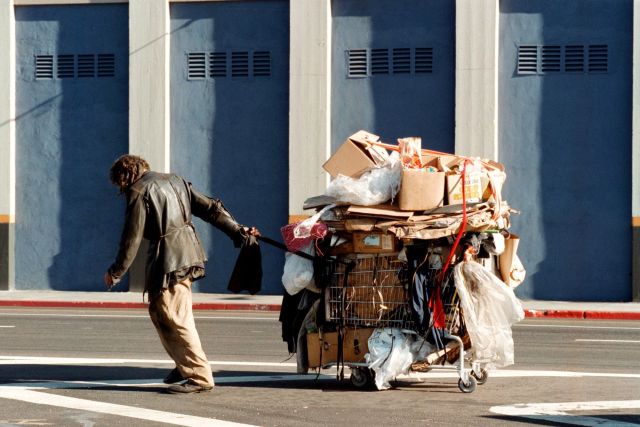Skid Row, LA. Credit: David McNew / Newsmakers

Where is ‘skid row’? I’d always assumed it was a purely metaphorical location, like ‘easy street’, it’s polar opposite.
True enough, the term can be used generically in reference to poor neighbourhoods across America – especially those known as gathering places for the homeless. However, Skid Row (note the capitalisation) is a far from metaphorical district of Los Angeles, which, as it happens, is known for its high level of homelessness.
In a stunning long read for American Affairs, Jacob Siegel visits Los Angeles to document a tide of homelessness that extends far beyond the borders of Skid Row:
“LA County reported 53,195 homeless people in 2018, with 31,516 of them inside the city of Los Angeles. If you’ve walked around LA in the past year, however, or listened to skeptical experts, you might suspect the real number is considerably higher.”
Homelessness in LA and its environs takes many forms – from makeshift tent cities to the RVs “parked bumper to bumper” along the Pacific Coast Highway to the people sleeping on the beach – “the encampments pushed out to the very edge of the ocean”.
But according to Siegel, Skid Row – “a more hellish concentration of deprivation and disorder than anything I’ve seen in America” – has the worst of it:
“The city has struggled to keep fewer than ten public toilets operating for the thousands of people who live on Skid Row. The first night I walked through the district, I passed a fenced-in area outside one of the missions where sand had been spread across the ground like cat litter.”
Observing the juxtaposition of wealth and squalor in California’s glistening cities, Siegel points out not only the contrast, but also the causal link:
“A December 2018 study by Zillow, the major online real estate database company, found that ‘communities where people spend more than 32 percent of their income on rent can expect a more rapid increase in homelessness’…
“In LA County, people spend 49 percent of their income on rent, according to the study. For every 2 percentage points that number goes up, the study found, an additional 4,227 people are likely to become homeless.”
Describing the gentrification of once affordable neighbourhoods, he says that the housing market “functions as an invisible messaging apparatus” and that the message to “the working and middle classes” is that you are “not necessary for the functioning of the city.”
Siegel’s take on the property market reminds me of the John Lanchester novel, Capital. The plot revolves around a sinister message, hand-delivered to every house in a once ordinary, but now very expensive, London Street. The anonymous note consists of just five words: “We Want What You Have.” If I read Lanchester correctly, it’s meant as an allegory of the (house) price mechanism.
The market value of your home is not a reflection of the intrinsic worth of the property, let alone your acumen as an ‘investor’. It’s just a measure of how much other people want what you have – which, primarily, is a stake in a location, not the building per se. Think of the price of your home as a notice to quit your neighbourhood, albeit with financial compensation.
Siegel makes a significant point when he says that “the homeless live outside the norms and reach of the [market’s] messaging infrastructure”. This, he says, is a “problem” – but who for? Not the homeless, who have enough problems of their own. Rather, the people with this particular problem are those who send the signals. The homeless, who have nothing, cannot be told “We Want What You Have” and therefore cannot be told, by means of the property market, where to live. Obviously, this immunity comes at a terrible cost, but when you can be homeless anywhere it might as well be somewhere warm, by the sea and where the crumbs that fall from the table are the best crumbs.
The level and visibility of homelessness in Los Angeles and San Francisco have turned the cities into icons of inequality – a living indictment of late capitalism. Of course, the fact that a particular place attracts homeless people from elsewhere cannot be held against it – and especially not where it provides support services for desperate people.
Yet, as mentioned, there are many forms of homelessness – and some tell us more about the times we live in than others. One of the most striking statistics in Siegel’s report is that there are “4,577 Recreational Vehicles housing an estimated 8,380 people across LA county” (and just to be clear, these aren’t happy campers, but people of no fixed abode).
As a vehicle for tourism, the RV is symbol of the sheer bounty of capitalism – the ubiquitous home-from-home, capable of crossing continents. But as a vehicle for homelessness it embodies the impermanence and insecurity of the system: an economy in which digital platforms offer uncertain employment on terms and timescales precisely calibrated to the owners’ interest alone; a society where the mutual obligations of family and community are degraded and stigmatised. In short, a culture of detachment, in which property prices serve as the universal solvent.










Join the discussion
Join like minded readers that support our journalism by becoming a paid subscriber
To join the discussion in the comments, become a paid subscriber.
Join like minded readers that support our journalism, read unlimited articles and enjoy other subscriber-only benefits.
Subscribe